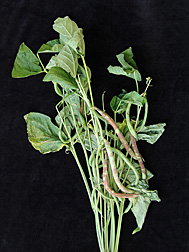Virus-Resistant Beans on Tap as
Insurance Against Chocolate Pod Disease
Don’t let the name fool you. The soybean aphid, Aphis glycines, also likes feeding on snap beans. Adding insult to injury is the pest’s transmission of many different types of viruses, including clover yellow vein virus. A strain of this virus, dubbed “ClYVV-WI,” is the chief culprit behind chocolate pod, a disease that causes unsightly defects on snap bean pods.
“Snap beans are sold fresh or processed for freezing or canning, so any defects on the pods make them unmarketable,” says ARS plant pathologist Richard Larsen.
Prevention is a challenge, because soybean aphids transmit their viral payloads within seconds of feeding. Also, chocolate pod outbreaks caused by aphid infestations can be hard to predict. But when outbreaks do occur, yield losses can reach 100 percent.
Now, a sequence of amino acids derived from the virus’s coat protein could prove to be its undoing. That’s because Larsen and ARS geneticist Phillip Miklas have used the sequence information to develop a PCR (polymerase chain reaction) test for detecting the chocolate pod virus and distinguishing it from other pathogens lurking in diseased plants.
The method, which yields results in less than a day, versus weeks by traditional biological methods, has become a critical screening tool in the search for resistant germplasm, says Larsen. He and Miklas are both with the ARS Vegetable and Forage Crops Research Laboratory in Prosser, Washington.
So far, only one snap bean variety out of 63 that the researchers have screened showed partial resistance to ClYVV-WI. But a survey of dry edible beans, including cultivars Raven and UI-31, proved more productive. “Subsequent genetic analysis revealed a gene conferring better resistance to ClYVV-WI in dry bean,” says Larsen. The gene is associated with another well-known virus-resistance gene, bc-3. Together, these genes confer resistance not only to ClYVV-WI, but also to the closely related pathogens bean common mosaic virus and bean yellow mosaic virus.
Eventually, the resistant dry bean plants will be crossbred with susceptible snap beans so they, too, will possess the gene near bc-3 or other such resistance genes that are found. Commercial cultivars developed from such crosses will be especially important for snap bean farmers in Wisconsin, Michigan, and other Great Lakes states, where the first outbreak of chocolate pod occurred in the $150 million crop in 2001—one year after soybean aphids arrived in the region.
“Because of the rapid transmission of ClYVV-WI by the soybean aphid, insecticide applications on snap bean crops are not effective or economically feasible,” says Larsen. “Incorporating resistance genes into the crop is a far better strategy.”—By Jan Suszkiw, Agricultural Research Service Information Staff.
This research is part of Plant Genetic Resources, Genomics, and Genetic Improvement, an ARS national program (#301) described on the World Wide Web at www.nps.ars.usda.gov.
Richard C. Larsen and Phillip N. Miklas are with the USDA-ARS Vegetable and Forage Crops Research Laboratory, 24106 N. Bunn Rd., Prosser, WA 99350; phone (509) 786-9258, fax (509) 786-9277.
"Virus-Resistant Beans on Tap as Insurance Against Chocolate Pod Disease" was published in the August 2009 issue of Agricultural Research magazine.







